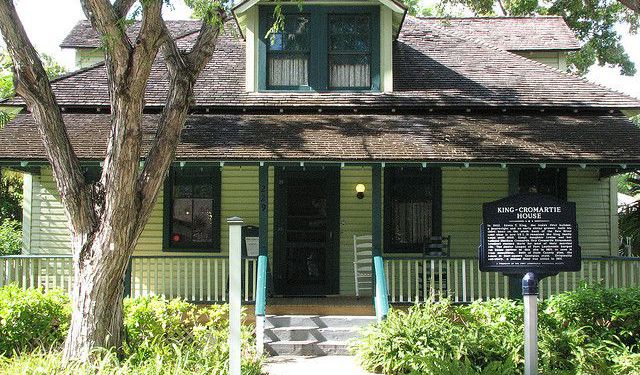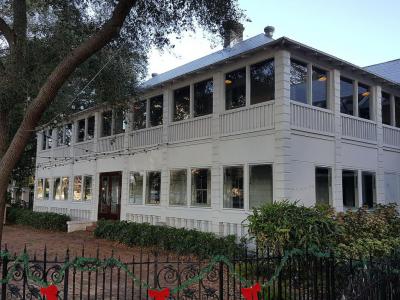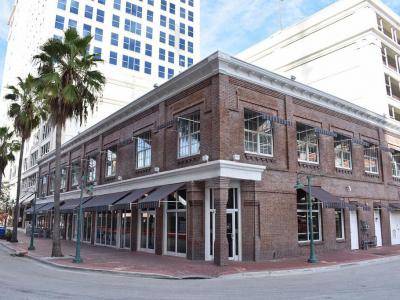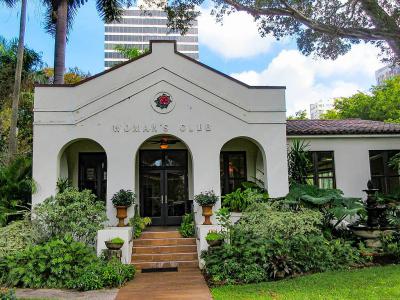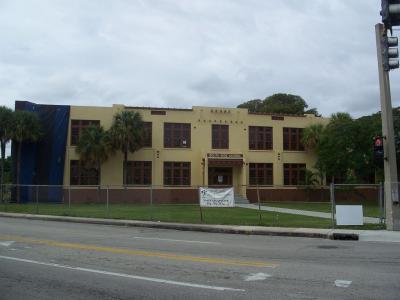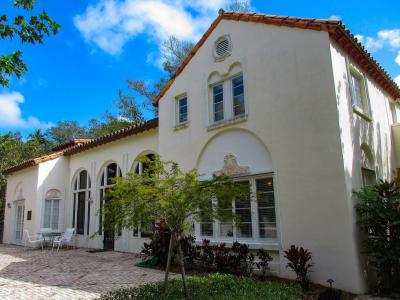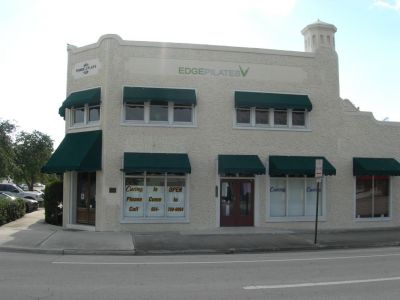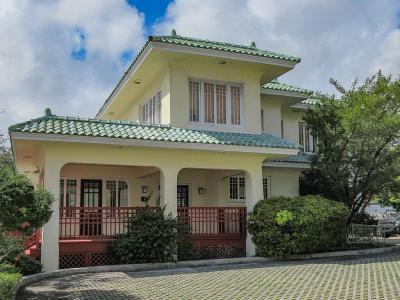Downtown Historical Buildings (Self Guided), Fort Lauderdale
Downtown Fort Lauderdale is home to three designated historic districts: The Sailboat Bend, The Himmarshee, and The Stranahan House. Each holds a range of houses and buildings from the mid-19th and 20th centuries that together tell the fascinating story of Fort Lauderdale's evolution over the years.
One such notable institution, preserving the city's heritage, is the Fort Lauderdale History Center. It stands as a repository of knowledge and showcases the area's history through exhibitions and artifacts.
The Bryan Building, an architectural gem, adds to the charm of the downtown area. Its elegant design and historic significance make it a sight not to miss for history enthusiasts.
The Woman's Club is another landmark with a storied past. It served as a hub for social and cultural activities in its heyday, representing the vital role women played in shaping the community.
The South Side Cultural Arts Center, formerly South Side School, offers a window into the educational history of Fort Lauderdale. Its transformation into an arts center highlights the city's commitment to preserving and repurposing historic buildings.
The Williams House is a well-preserved example of the city's residential architecture. It stands as a testament to the lifestyles of the past.
The Croissant Park Administration Building, while more recent than some others, contributes to the historical fabric of the area. It showcases modernist architectural elements, a contrast to older structures.
The Sam Gilliam House is yet another noteworthy residence, reflecting the unique architecture of its time and offering a glimpse into the lives of Fort Lauderdale's residents.
Given the condition of these historical gems, it is obvious that locals cherish and protect their heritage. Your visit also can be a meaningful contribution to the legacy of Fort Lauderdale. So, take this self-guided walk to explore historical buildings in downtown Fort Lauderdale and ensure that these treasures remain an integral part of its vibrant cityscape for generations to come.
One such notable institution, preserving the city's heritage, is the Fort Lauderdale History Center. It stands as a repository of knowledge and showcases the area's history through exhibitions and artifacts.
The Bryan Building, an architectural gem, adds to the charm of the downtown area. Its elegant design and historic significance make it a sight not to miss for history enthusiasts.
The Woman's Club is another landmark with a storied past. It served as a hub for social and cultural activities in its heyday, representing the vital role women played in shaping the community.
The South Side Cultural Arts Center, formerly South Side School, offers a window into the educational history of Fort Lauderdale. Its transformation into an arts center highlights the city's commitment to preserving and repurposing historic buildings.
The Williams House is a well-preserved example of the city's residential architecture. It stands as a testament to the lifestyles of the past.
The Croissant Park Administration Building, while more recent than some others, contributes to the historical fabric of the area. It showcases modernist architectural elements, a contrast to older structures.
The Sam Gilliam House is yet another noteworthy residence, reflecting the unique architecture of its time and offering a glimpse into the lives of Fort Lauderdale's residents.
Given the condition of these historical gems, it is obvious that locals cherish and protect their heritage. Your visit also can be a meaningful contribution to the legacy of Fort Lauderdale. So, take this self-guided walk to explore historical buildings in downtown Fort Lauderdale and ensure that these treasures remain an integral part of its vibrant cityscape for generations to come.
How it works: Download the app "GPSmyCity: Walks in 1K+ Cities" from Apple App Store or Google Play Store to your mobile phone or tablet. The app turns your mobile device into a personal tour guide and its built-in GPS navigation functions guide you from one tour stop to next. The app works offline, so no data plan is needed when traveling abroad.
Downtown Historical Buildings Map
Guide Name: Downtown Historical Buildings
Guide Location: USA » Fort Lauderdale (See other walking tours in Fort Lauderdale)
Guide Type: Self-guided Walking Tour (Sightseeing)
# of Attractions: 7
Tour Duration: 2 Hour(s)
Travel Distance: 3.4 Km or 2.1 Miles
Author: christine
Sight(s) Featured in This Guide:
Guide Location: USA » Fort Lauderdale (See other walking tours in Fort Lauderdale)
Guide Type: Self-guided Walking Tour (Sightseeing)
# of Attractions: 7
Tour Duration: 2 Hour(s)
Travel Distance: 3.4 Km or 2.1 Miles
Author: christine
Sight(s) Featured in This Guide:
- Fort Lauderdale History Center
- Bryan Building
- Woman's Club
- South Side Cultural Arts Center (South Side School)
- Williams House
- Croissant Park Administration Building
- Sam Gilliam House
1) Fort Lauderdale History Center (must see)
The museum formerly known as the Old Fort Lauderdale Village and Museum is now the Fort Lauderdale History Center. Also known as History Fort Lauderdale, the primary museum is located at the western entrance of the Fort Lauderdale Riverwalk.
The New River Inn is the site of History Fort Lauderdale. It was constructed in 1905, built by Edwin T. King and commissioned by United States Senator Nathan Philemon Bryan. Visitors can explore the grounds of History Fort Lauderdale or take a guided tour. This museum details the history of Fort Lauderdale.
There are a number of other buildings that are open for exploration. The Pioneer House Museum, or the King-Cromartie House, is a fully preserved home that showcases the early days of Fort Lauderdale. The 1899 Schoolhouse Museum offers a glimpse into turn-of-the-century education. The Hoch Research Library offers newspaper clippings, photos, maps and blueprints.
The Philemon Bryan House is part of the Fort Lauderdale History Center as well. This house is the oldest example of residential masonry architecture in the city. It is also reputed to be haunted by Lucy Catherine Bryan, which makes it a popular spot for ghost hunters and those who simply enjoy spooky stories.
The New River Inn is the site of History Fort Lauderdale. It was constructed in 1905, built by Edwin T. King and commissioned by United States Senator Nathan Philemon Bryan. Visitors can explore the grounds of History Fort Lauderdale or take a guided tour. This museum details the history of Fort Lauderdale.
There are a number of other buildings that are open for exploration. The Pioneer House Museum, or the King-Cromartie House, is a fully preserved home that showcases the early days of Fort Lauderdale. The 1899 Schoolhouse Museum offers a glimpse into turn-of-the-century education. The Hoch Research Library offers newspaper clippings, photos, maps and blueprints.
The Philemon Bryan House is part of the Fort Lauderdale History Center as well. This house is the oldest example of residential masonry architecture in the city. It is also reputed to be haunted by Lucy Catherine Bryan, which makes it a popular spot for ghost hunters and those who simply enjoy spooky stories.
2) Bryan Building
The historic Bryan Building is located in central Fort Lauderdale. It is an important historical building in the city. The building represents the Masonry Vernacular style due to its sourcing of local materials. It is unique for this area due to its brick facade, which is rare in southern Florida.
The Bryan Building was built by Thomas Bryan and was completed in 1914. Placed in the heart of the Fort Lauderdale commercial district, the Bryan Building held a US Post Office and the Fort Lauderdale Bank. It also served as a hotel over the years.
Tourists can plan to walk by the Bryan Building as they explore the many other interesting places in the city. It is located near the Fort Lauderdale Riverwalk and only one block west of the NSU Art Museum.
The Bryan Building was added to the National Register of Historic Places in 1997.
The Bryan Building was built by Thomas Bryan and was completed in 1914. Placed in the heart of the Fort Lauderdale commercial district, the Bryan Building held a US Post Office and the Fort Lauderdale Bank. It also served as a hotel over the years.
Tourists can plan to walk by the Bryan Building as they explore the many other interesting places in the city. It is located near the Fort Lauderdale Riverwalk and only one block west of the NSU Art Museum.
The Bryan Building was added to the National Register of Historic Places in 1997.
3) Woman's Club
Many visitors associate Fort Lauderdale with beaches and spring break festivities. While these are certainly not to be overlooked, there are also a great many historic buildings in this south Florida city. One of these is the Fort Lauderdale Women's Club.
The building was constructed in 1916 and dedicated in 1917. It was designed by prominent architect August Geiger who used the Mediterranean Revival style. The Women's Club was the first architecturally designed building in the city, which is one of the reasons it was included on the National Register of Historic Places. The building is also noted for its role as a social club that gave women a place to learn and talk about politics, education and literature.
The Women's Club wasn't just a social club. It also served as the location of the city's first Red Cross headquarters. The first Girl Scout Troop was founded in this building. Even the planning of Fort Lauderdale by city planner Richard Schermerhorn, Jr. took place in this building. Today, the Women's Club is a popular location for festivals, meetings and arts & crafts shows.
Visitors to Fort Lauderdale can enjoy the history of the Women's Club while also exploring the adjacent Stranahan Park. The botanical park includes mature trees, a butterfly garden, a tropical garden, a succulent garden and over 500 varieties of plants.
The building was constructed in 1916 and dedicated in 1917. It was designed by prominent architect August Geiger who used the Mediterranean Revival style. The Women's Club was the first architecturally designed building in the city, which is one of the reasons it was included on the National Register of Historic Places. The building is also noted for its role as a social club that gave women a place to learn and talk about politics, education and literature.
The Women's Club wasn't just a social club. It also served as the location of the city's first Red Cross headquarters. The first Girl Scout Troop was founded in this building. Even the planning of Fort Lauderdale by city planner Richard Schermerhorn, Jr. took place in this building. Today, the Women's Club is a popular location for festivals, meetings and arts & crafts shows.
Visitors to Fort Lauderdale can enjoy the history of the Women's Club while also exploring the adjacent Stranahan Park. The botanical park includes mature trees, a butterfly garden, a tropical garden, a succulent garden and over 500 varieties of plants.
4) South Side Cultural Arts Center (South Side School)
South Side Cultural Arts Center is a former school that is now used for performing arts, culinary classes, fitness and tennis. Visitors will want to see the South Side Cultural Arts Center to admire its architecture and its history.
The school first opened in 1922. At that time, it was the city's first elementary school. It remained in use as an elementary school until 1969, and then as a public use building for children's services through 1990. It is one of the earliest buildings in the city that have survived.
Left vacant for a time, the city of Fort Lauderdale eventually refurbished the 11,000 square foot building to be used as a community center.
The building is located in the midst of Florence C. Hardy Park, which has ample green space and a large playground that is perfect for visiting children. It is an easy walk from the banks of the New River from the north and the Tarpon River from the south.
The school first opened in 1922. At that time, it was the city's first elementary school. It remained in use as an elementary school until 1969, and then as a public use building for children's services through 1990. It is one of the earliest buildings in the city that have survived.
Left vacant for a time, the city of Fort Lauderdale eventually refurbished the 11,000 square foot building to be used as a community center.
The building is located in the midst of Florence C. Hardy Park, which has ample green space and a large playground that is perfect for visiting children. It is an easy walk from the banks of the New River from the north and the Tarpon River from the south.
5) Williams House
The Williams House in Fort Lauderdale is a significant example of the city's architectural and social heritage. Built during the vibrant era of the South Florida land boom, the house encapsulates the opulence and optimism of its time. Developed by G. Frank Croissant on two lots along the scenic Tarpon River, within the prosperous Croissant Park subdivision, the house reflects the era's architectural elegance and residential development success.
Designed by local architect Courtney Stewart, the Williams House showcases characteristic features of the Mediterranean Revival Style. The building features a sleek stucco exterior with decorative details like cast concrete roof brackets and gable vents. Its foundation is sturdy, made of concrete blocks with reinforced columns. The clay barrel tile roof and irregular footprint give it character. Moreover, the property includes a variety of amenities such as a pool, parking area, and well-considered landscaping.
Located on Rose Drive, a picturesque enclave along a section of the Tarpon River, the Williams House enjoys a nearly rural atmosphere despite its proximity to downtown Fort Lauderdale. This area is distinguished by its meandering streets, mature trees, estate-like lots, and the whimsical presence of free-roaming peacocks, adding a unique character to the neighborhood.
Originally built for the Williams family, known for their successful dairy business, and the popular Williams McWilliams Ice Cream Store, the house has been home to notable residents, including C. Shelby Dale, a local attorney and former Fort Lauderdale City Attorney.
The Williams House, once a residence, now offers vital support as a haven for those battling cancer. Through Gilda’s Club, it provides a nurturing community with support groups, lectures, and social events, ensuring individuals facing cancer find solace and companionship on their journey.
Designed by local architect Courtney Stewart, the Williams House showcases characteristic features of the Mediterranean Revival Style. The building features a sleek stucco exterior with decorative details like cast concrete roof brackets and gable vents. Its foundation is sturdy, made of concrete blocks with reinforced columns. The clay barrel tile roof and irregular footprint give it character. Moreover, the property includes a variety of amenities such as a pool, parking area, and well-considered landscaping.
Located on Rose Drive, a picturesque enclave along a section of the Tarpon River, the Williams House enjoys a nearly rural atmosphere despite its proximity to downtown Fort Lauderdale. This area is distinguished by its meandering streets, mature trees, estate-like lots, and the whimsical presence of free-roaming peacocks, adding a unique character to the neighborhood.
Originally built for the Williams family, known for their successful dairy business, and the popular Williams McWilliams Ice Cream Store, the house has been home to notable residents, including C. Shelby Dale, a local attorney and former Fort Lauderdale City Attorney.
The Williams House, once a residence, now offers vital support as a haven for those battling cancer. Through Gilda’s Club, it provides a nurturing community with support groups, lectures, and social events, ensuring individuals facing cancer find solace and companionship on their journey.
6) Croissant Park Administration Building
The Croissant Park Administration Building in Fort Lauderdale symbolizes the city's rich history. Constructed in 1923, this iconic structure exemplifies the Mission Revival architectural style, a design choice believed to be the brainchild of Francis Abreu, a prolific architect who left a significant mark on Fort Lauderdale's architectural landscape during the roaring 1920s.
This L-shaped, two-story building is crafted from poured concrete and is adorned with a textured stucco exterior that speaks to the era's penchant for intricate details. Adding to its historic charm are concrete lamps that grace the roof corners, illuminating its architectural beauty. The building greets visitors with a distinct cut-corner entrance, leading into a realm where the past meets the present. Its flat roof is accented with parapets, further emphasizing its Mission Revival style.
The interior of the Croissant Park Administration Building is equally impressive. A staircase made of cypress wood ascends to the second floor, revealing floors constructed from Dade Pine, a material renowned for its durability and beauty. This building once served as the nerve center for the Croissant Park development, spearheaded by G. Frank Croissant. In 1924, Croissant embarked on an ambitious project, purchasing 1,200 acres and transforming it into one of Fort Lauderdale's most significant developments during the Florida land boom of the 1920s.
In recognition of its historical and architectural significance, the Croissant Park Administration Building was rightfully added to the U.S. National Register of Historic Places in 2001. Today, it stands not only as a testament to Fort Lauderdale's dynamic growth during the early 20th century but also as a preserved piece of history that continues to captivate and educate those who visit.
This L-shaped, two-story building is crafted from poured concrete and is adorned with a textured stucco exterior that speaks to the era's penchant for intricate details. Adding to its historic charm are concrete lamps that grace the roof corners, illuminating its architectural beauty. The building greets visitors with a distinct cut-corner entrance, leading into a realm where the past meets the present. Its flat roof is accented with parapets, further emphasizing its Mission Revival style.
The interior of the Croissant Park Administration Building is equally impressive. A staircase made of cypress wood ascends to the second floor, revealing floors constructed from Dade Pine, a material renowned for its durability and beauty. This building once served as the nerve center for the Croissant Park development, spearheaded by G. Frank Croissant. In 1924, Croissant embarked on an ambitious project, purchasing 1,200 acres and transforming it into one of Fort Lauderdale's most significant developments during the Florida land boom of the 1920s.
In recognition of its historical and architectural significance, the Croissant Park Administration Building was rightfully added to the U.S. National Register of Historic Places in 2001. Today, it stands not only as a testament to Fort Lauderdale's dynamic growth during the early 20th century but also as a preserved piece of history that continues to captivate and educate those who visit.
7) Sam Gilliam House
The Sam Gilliam House, also known as the Gilliam-Adams House, stands as a significant landmark in Fort Lauderdale. Constructed in 1925 by Sam Gilliam, the proprietor of a lumber company, this two-story residence showcases elements from both the Mediterranean Revival and Prairie School architectural styles. Its design features a flat roof with parapets concealed by pent roofs adorned with green barrel tiles.
Aside from his business ventures, Sam Gilliam was actively involved in local politics, particularly within the Republican party. His house was not only a place of residence but also a showcase of his wealth and influence. Inside, intricate woodwork adorned the interiors, creating a lavish setting fit for hosting esteemed guests, including reputedly U.S. presidents. Gilliam's political involvement extended to national platforms, as he served as a delegate to various Republican National Conventions and potentially entertained notable figures like Herbert Hoover.
Originally situated at the corner of SE 9th Street and SE 3rd Avenue, the Gilliam house was constructed during the peak of Florida's 1920s land boom. However, by 1998, the house faced relocation, and it was offered for free to anyone willing to move it from its original location. The current owners undertook the task, relocating the 3,900 square foot structure to its present site adjacent to the historic Croissant Park Administration Building on 15th Street in July 1998.
Aside from his business ventures, Sam Gilliam was actively involved in local politics, particularly within the Republican party. His house was not only a place of residence but also a showcase of his wealth and influence. Inside, intricate woodwork adorned the interiors, creating a lavish setting fit for hosting esteemed guests, including reputedly U.S. presidents. Gilliam's political involvement extended to national platforms, as he served as a delegate to various Republican National Conventions and potentially entertained notable figures like Herbert Hoover.
Originally situated at the corner of SE 9th Street and SE 3rd Avenue, the Gilliam house was constructed during the peak of Florida's 1920s land boom. However, by 1998, the house faced relocation, and it was offered for free to anyone willing to move it from its original location. The current owners undertook the task, relocating the 3,900 square foot structure to its present site adjacent to the historic Croissant Park Administration Building on 15th Street in July 1998.
Walking Tours in Fort Lauderdale, Florida
Create Your Own Walk in Fort Lauderdale
Creating your own self-guided walk in Fort Lauderdale is easy and fun. Choose the city attractions that you want to see and a walk route map will be created just for you. You can even set your hotel as the start point of the walk.
Fort Lauderdale Beach Walking Tour
For decades, Fort Lauderdale Beach has been known primarily as a destination for raucous college students to celebrate Spring Break. Today, although a bit calmer and less chaotic than before, this neighborhood still boasts a wealth of opportunities for recreation, relaxation, and enjoyment.
One of the notable local attractions is the Bonnet House Museum and Gardens. This historic estate... view more
Tour Duration: 2 Hour(s)
Travel Distance: 4.9 Km or 3 Miles
One of the notable local attractions is the Bonnet House Museum and Gardens. This historic estate... view more
Tour Duration: 2 Hour(s)
Travel Distance: 4.9 Km or 3 Miles
Fort Lauderdale Downtown Walking Tour
Fort Lauderdale is known for beautiful beaches and tourism. As part of the Miami metropolitan area, Fort Lauderdale offers the advantage of city culture and convenience along with warm weather, sand and sea.
Fort Lauderdale was originally inhabited by the Tequesta. Like many other native people, they faced disease and expulsion when European explorers made their way to the Florida shores.
... view more
Tour Duration: 1 Hour(s)
Travel Distance: 1.5 Km or 0.9 Miles
Fort Lauderdale was originally inhabited by the Tequesta. Like many other native people, they faced disease and expulsion when European explorers made their way to the Florida shores.
... view more
Tour Duration: 1 Hour(s)
Travel Distance: 1.5 Km or 0.9 Miles
The Most Popular Cities
/ view all
